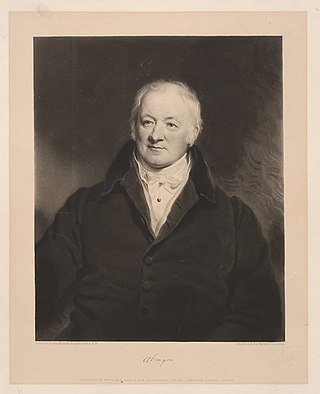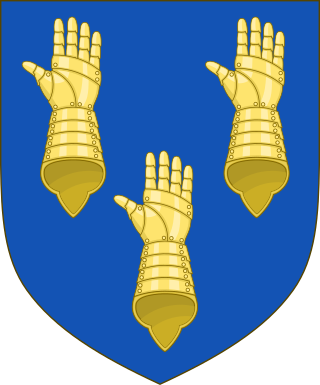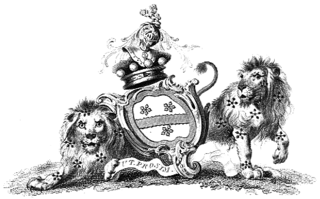
Marquess of Aberdeen and Temair, in the County of Aberdeen, in the County of Meath and in the County of Argyll, is a title in the Peerage of the United Kingdom. It was created on 4 January 1916 for John Hamilton-Gordon, 7th Earl of Aberdeen.

James Scarlett, 1st Baron Abinger, was an English lawyer, politician and judge.

Earl of Derby is a title in the Peerage of England. The title was first adopted by Robert de Ferrers, 1st Earl of Derby, under a creation of 1139. It continued with the Ferrers family until the 6th Earl forfeited his property toward the end of the reign of Henry III and died in 1279. Most of the Ferrers property and the Derby title were then held by the family of Henry III. The title merged in the Crown upon Henry IV's accession to the throne in 1399.

Viscount Melbourne, of Kilmore in the County of Cavan, was a title in the Peerage of Ireland held by the Lamb family.

Thomas Wilde, 1st Baron Truro, was a British lawyer, judge, and politician. He was Lord High Chancellor of Great Britain between 1850 and 1852.

John Campbell, 1st Baron Campbell, PC, QC, FRSE was a British Liberal politician, lawyer and man of letters.
Earl Fortescue is a title in the Peerage of Great Britain that was created in 1789 for Hugh Fortescue, 3rd Baron Fortescue (1753–1841), a member of parliament for Beaumaris and Lord-Lieutenant of Devon.

Baron Barnard, of Barnard Castle in the Bishopric of Durham, is a title in the Peerage of England. It was created in 1698 for Christopher Vane, who had previously served as a member of parliament for County Durham and Boroughbridge. Vane was the son of Sir Henry Vane the Younger and grandson of Sir Henry Vane the Elder. His grandson, the third Baron, notably served as Paymaster of the Forces and as Lord Lieutenant of County Durham. In 1754 he was created Viscount Barnard and Earl of Darlington, both in the County Palatine of Durham. Lord Darlington was the husband of Lady Grace FitzRoy, daughter of Charles FitzRoy, 2nd Duke of Cleveland, the illegitimate son of King Charles II by his mistress Barbara Villiers, 1st Duchess of Cleveland.

Earl of Bessborough is a title in the Peerage of Ireland. It was created in 1739 for Brabazon Ponsonby, 2nd Viscount Duncannon, who had previously represented Newtownards and County Kildare in the Irish House of Commons. In 1749, he was given the additional title of Baron Ponsonby of Sysonby, in the County of Leicester, in the Peerage of Great Britain, which entitled him to a seat in the British House of Lords. The titles Viscount Duncannon, of the fort of Duncannon in the County of Wexford, and Baron Bessborough, of Bessborough, Piltown, in the County of Kilkenny, had been created in the Peerage of Ireland in 1723 and 1721 respectively for Lord Bessborough's father William Ponsonby, who had earlier represented County Kilkenny in the Irish House of Commons.

Earl of Harewood, in the County of York, is a title in the Peerage of the United Kingdom.

Earl of Effingham, in the County of Surrey, is a title in the Peerage of the United Kingdom, created in 1837 for Kenneth Howard, 11th Baron Howard of Effingham, named after the village of Effingham, Surrey, where heads of the family owned the manor.

Earl of Lovelace was a title in the Peerage of the United Kingdom. It was created in 1838 for William King-Noel, 8th Baron King, a title created in 1725.

Earl of Strafford is a title that has been created three times in English and British history.

Baron Foley is a title that has been created twice in the Peerage of Great Britain, both times for members of the same family.

Baron Abinger, of Abinger in the County of Surrey and of the City of Norwich, is a title in the Peerage of the United Kingdom. It was created on 12 January 1835 for the prominent lawyer and politician Sir James Scarlett, the Lord Chief Baron of the Exchequer. Lord Abinger was succeeded by his eldest son, the second baron. He represented Norwich and Horsham in the House of Commons. He was succeeded by his son, the third baron. He was a lieutenant-general in the army and fought in the Crimean War. On the death of his son, the fourth baron, the line of the eldest son of the first baron failed. The late baron was succeeded by his second cousin, the fifth baron. He was the grandson of Peter Campbell Scarlett, third son of the first baron. When he died the title passed to his younger brother, the sixth baron, and then to another brother, the seventh baron. As of 2016 the title is held by the latter's grandson, the ninth baron, who succeeded his father in 2002.

Viscount Clifden, of Gowran in the County of Kilkenny, Ireland, was a title in the Peerage of Ireland. It was created on 12 January 1781 for James Agar, 1st Baron Clifden. He had already been created Baron Clifden, of Gowran in the County of Kilkenny, in 1776, also in the Peerage of Ireland. The Viscounts also held the titles of Baron Mendip in the Peerage of Great Britain from 1802 to 1974 and Baron Dover from 1836 to 1899, when this title became extinct, and Baron Robartes from 1899 to 1974, when this title became extinct, the two latter titles which were in the Peerage of the United Kingdom. The interrelated histories of the peerages follow below.

Baron Dufferin and Claneboye, of Ballyleidy and Killyleagh in County Down, Northern Ireland, is a title in the Peerage of Ireland. It was created on 30 July 1800 for Dame Dorcas Blackwood, widow of Sir John Blackwood, 2nd Baronet, Member of the Irish Parliament for Killyleagh and Bangor, in return for support for the Union of Ireland and the United Kingdom.

Baron North, of Kirtling Tower in the County of Cambridge, is an abeyant title in the Peerage of England. Its most famous holder was Frederick North, 2nd Earl of Guilford, 8th Baron North, who served as Prime Minister of Great Britain from 1770 to 1782, a period which included most of the American Revolutionary War.
Peers of the Realm have been associated with Australia since early in its history as a British settlement. Many peers served as governors of the Australian colonies, and in the days when the practice of appointing British governors-general was current, the great majority were peers.

William Frederick Campbell, 2nd Baron Stratheden, 2nd Baron Campbell, was a British peer and Liberal politician. His father was the Lord Chancellor.















